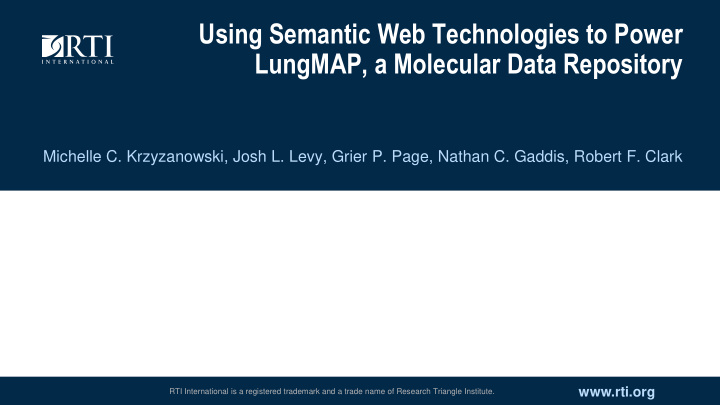



Using Semantic Web Technologies to Power LungMAP, a Molecular Data Repository Michelle C. Krzyzanowski, Josh L. Levy, Grier P. Page, Nathan C. Gaddis, Robert F. Clark www.rti.org RTI International is a registered trademark and a trade name of Research Triangle Institute.
What drives advancements in biomedical research? Data Collaboration Analysis Tools Importantly, open data that is easily accessible is key to progressing ongoing biomedical research and our understanding of what is known.
There is a need to develop standards for biomedical data Large scale data is continually being generated by: Hospitals Academic Institutions Industry and Biotech As the amount of data collected grows exponentially, this necessitates a need to standardize stored data format and develop tools to store analyze the data to make it easy to find , accessible and reusable .
Working cooperatively to standardize data format and integration Plan and Push Establish a Primary Recruit Researchers a Feasible Standard To Contribute and Data Storage Location Submit Data Our data follows a standard format, creating a freely accessible public source.
LungMAP: http://lungmap.net
LungMAP stemmed from a NHLBI Initiative
RTI’s Contributions As part of the Data Coordinating Center (DCC): LungMAP Portal (Website) BREATH (Database) Website development and Operating procedures for data maintenance management Creation of web tools to browse Data processing, integration and and interpret data maintenance into BREATH DB Maintenance of Cloud services SPARQL queries used Management of ontology of lung development, including cells, structures, and cross-species comparison
What data does LungMAP provide? The proper development of an PolII organism is carefully orchestrated by: Gene expression Protein A Protein-protein interactions Protein B Cell-cell interactions All are critical for correct Cell A Cell B development of all organ systems and the organism as a whole.
What data does LungMAP provide? Any changes to the expression, PolII availability or interaction of genes, proteins and metabolites may result in improper Protein A development. Protein B Therefore, mapping what genes are expressed, what proteins are present and the anatomical Cell A Cell B placement of cells may indicate what markers or combination of markers can lead to improper development.
Ontologies: Useful for mapping anatomical information Using anatomical terms, Human lists of genes, proteins, part_of lipids, etc., we apply their Arm relationships through is_a ontologies and triple store databases. Left Arm part_of part_of Anatomical terms become Forearm Upper Arm part_of part_of entities and their known biological hierarchy to each Elbow part_of Wrist other establishes the Hand relations . part_of Finger
Ontologies: Useful for mapping anatomical information A subset of LungMAP’s ontology Using anatomical terms, lists of genes, proteins, lipids, etc., we apply their relationships through ontologies and triple store databases. Anatomical terms become entities and their known biological hierarchy to each other establishes the relations .
LungMAP has been designed with the researcher in mind At the web portal, experimental and biologic sample data is visualized for user-case scenarios, such as: A researcher interested in browsing available data of a particular experiment type. A researcher interested in finding data from all experiment types related to a specific term of interest. A researcher seeking specific reagents or detecting certain genes or proteins during lung development.
Searching for information on a gene A user arrives to LungMAP and conducts a search “ Acta1 ” After arriving at the gene information page, they click to view all Single-cell RNA-seq experiments
Searching for information on a gene A user arrives to LungMAP and conducts a search “ Acta1 ” After arriving at the gene information page, they click to view all Single-cell RNA-seq experiments The following ontology patterns are used to retrieve all single-cell RNA-seq experiments associated with Acta1
Single-cell RNA-seq experiments for gene Acta1
Using Ontologies and Triple Stores for Image Annotation LungMAP features a large inventory of microscopic images of lung tissue. To understand what is pictured, labels and annotations are required. The following ontology patterns are used to create and retrieve annotations of images, including position on the image, label and annotator. Image annotation uses OpenLayers.
Using Ontologies and Triple Stores for Image Annotation
LungMAP promotes collaboration Hospitals Academic Institutions
Biomedical research is ever- evolving. Therefore, data and associated ontologies must also be flexible to change.
Future Works Integromics tool for analyzing biological molecules across omics data types RESTful API for accessing BREATH database Improved data visualization tools Expansion of a story builder tool that enables users to create pages describing findings derived from BREATH data New data types: nanoDESI, methylation, metabolomics
Acknowledgements Data Coordinating Center (RTI/Duke) Consortium Members Nathan Gaddis Namasivayam Ambalavanan Josh Levy Charles Ansong Martin Duparc Jacqueline Bagwell Michelle Krzyzanowski Cliburn Chan Stephen Hwang Charles Frevert Grier Page Davera Gabriel Mary-Anne Ardini Sina Gharib Robert Clark James Hagood Carol Hill Carol Hill Jeanne Holden-Wiltse Anil Jegga Ontology Working Group Tom Mariani Gail Deutsch Anna Maria Masci Helen Pan Wei Shi Susan Wert David Warburton Kathryn Wikenheiser-Brokamp NIH Award Number U01HL122638
Thank you.
Recommend
More recommend